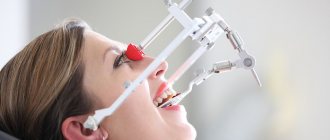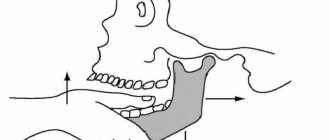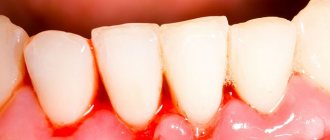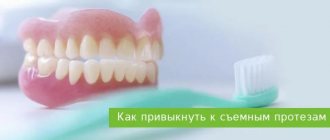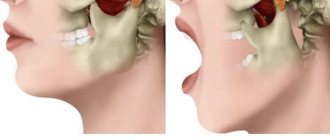Head on one side
Discomfort in the jaw is most often associated with problems in the temporomandibular joint, formed by the head of the lower jaw and the tubercle of the temporal bone, which, together with the articular disc, are enclosed in the articular capsule.
The movements in this joint are very complex: they are carried out not only by the masticatory muscle, but also by six other adjacent muscles. The movements of the lower jaw help us not only when eating, but also during conversation, laughter, and coughing. Related article Most patients with jaw dislocation are women
It is not surprising that the temporomandibular joint, according to medical observations, serves as the center of balance for the entire human body. With a symmetrical position of the lower jaw, the head muscles do not experience tension, and displacement of the lower jaw in any direction leads to an imbalance of the head. Problems in this area affect the muscles of the head, neck, temporomandibular joints, and cranial nerves and cause chronic pain on one side or, less commonly, on both sides of the face and head. Usually this condition has a very depressing effect on the patient; he completely “loses himself” and is unable to think about anything other than eliminating the pain.
Pain may appear in the morning, during the day or in the evening, this depends on the different types of joint damage and is important for the doctor to make a diagnosis.
Mouth shut. What to do if you have problems with your jaw joints
Read more
How does the disease manifest itself?
Painful sensations in the jaw area are usually associated with dysfunction of the temporomandibular joint. It, like all other joints, has a capsule where quite complex muscle movements occur. And this is not surprising, because with its help many life processes occur, such as biting, chewing, yawning, communicating, coughing, laughing, etc.
According to many scientists, this joint is also responsible for balance in the body. So, if the jaw is in the correct position, then the remaining muscles of the face and head, in general, are not subject to heavy loads and do not experience discomfort. When the joint is shifted to one side, the center of gravity of the head changes, as a result of which not only the head, but also the neck begins to suffer. In addition, the cranial nerves may be pinched, causing the person to experience constant spasms.
Unpleasant sensations, such as cramping and pain in the jaw, can be present both day and night. Moreover, at night the pain can become even stronger. Much here depends on the psychological state of a person. Any stressful situation or lack of sleep can cause increased pain.
To the dentist!
The cause of discomfort may also be due to incorrect position of the teeth. In this case, you will need the help of a maxillofacial dentist who will supply temporary or permanent splints and dentures that correct the incorrect position of the jaw.
Article on the topic
A tooth for a tooth: what happens if the jaws don’t close?
A rehabilitation doctor can help if the pain is caused by increased tone or tension of the masticatory muscles, limited mobility of the lower jaw, incoordination of contractions of the masticatory muscles, excessive mobility of the head of the lower jaw (sometimes this causes “clicking” in the temporomandibular joint).
Pain and clicking disappear after normalization of the function of the masticatory muscles and joint, except in cases where arthrosis deformans and inflammation in the joint are diagnosed. Then treatment should begin with following the recommendations of a rheumatologist and orthopedist.
Bruxism
A disease such as bruxism is manifested by strong clenching of the jaws during sleep and grinding of teeth. As a result of the disease, teeth become less stable and begin to loosen. Plus, the crowns wear out. Often this pathology leads to disruption of the functioning of the maxillotemporal joint.
Bruxism is characterized by spasmodic pain that appears after waking up. The pain can radiate not only to the jaw, but also spread throughout the head. People with this disease often complain that their teeth and jaw are cramping, which indicates overstrain of the joint.
Many “owners” of bruxism may not even know about the existence of the disease until someone tells them that they grind their teeth a lot in their sleep, or until they visit a dentist who sees that there is a problem.
Attention - facial expressions!
After complex treatment, patients are recommended to use medicated mouth guards at night. They are made individually by the orthodontist. The pads reduce pain in the joint, an unpleasant feeling of heaviness, fatigue in the masticatory muscles, neck muscles, and normalize mouth opening.
In order to prevent this very annoying nuisance from happening again, you need to avoid active conversations while eating, an excited manner of speaking when a person does not notice what is happening with his facial expressions, as well as hypothermia, which can provoke inflammation in the joint, which makes him more prone to to incorrect movements, more vulnerable.
Why does jaw pain occur?
Read more
Jaw spasms when yawning
No less common are complaints that the jaw tightens when yawning. Their frequency is due to the fact that people yawn frequently, and during this process the tone of the jaw muscles is lost for a certain time. If there was residual tension before yawning, then at the end of the process the muscles become hypertonic, the jaw joint undergoes increased stress, as a result of which the jaw cramps.
If consolidation occurs with every small yawn, especially when the process is accompanied by pain and slight swelling, you should go to a neurologist, traumatologist or dentist. There is a possibility that in this way an old injury makes itself felt or an orthodontic defect develops in the oral cavity. Also, a tumor in this area can interfere with a full yawn.
One way or another, if there is discomfort when yawning, it is recommended to apply a cooling compress. On this day, you should consume ground food so as not to strain the jaw muscles when chewing and give the joint a chance to rest.
Treatment
If the jaw is cramped on one side and at the same time there is elevated temperature and swelling, the first thing to do is contact a surgeon. It is possible that this condition arose as a result of purulent inflammation in this place. Similar symptoms may indicate the development of a paratonsillar abscess associated with tonsillitis.
When the lower part of the face is brought together on one side with irradiation into the orbit, inflammation of the facial artery can be suspected. In this case, you should visit a surgeon.
Severe and boring pain radiating to the jaw may indicate inflammation of the trigeminal nerve, and here you cannot do without a visit to a neurologist.
If the jaw is cramped due to improper placement of the dentition, you will need the help of a dentist who will install splints and dentures to avoid problems in the future.
Constant pain in the jaw may indicate the appearance of a tumor in the facial area. As the disease progresses, the pain will become more severe and aching. Therefore, if jaw contraction and pain persist for a long time and the pain is pulsating in nature, you should urgently consult a doctor in order to begin treatment on time and stop the growth of the tumor.
Treatment of trismus of masticatory muscles in Saransk
Treatment of trismus is aimed primarily at helping the victim and subsequently relieving restrictions and pain from the masticatory muscles, as well as determining the nature of the onset of the disease. If trismus is in the nature of the occurrence of purulent-infectious processes in the oral cavity, for example, an abscess, then the dentist eliminates the source of inflammation of the purulent infection, cleans the hole, and if it is not possible to save the diseased tooth, then removes it from the roots, thereby eliminating the cause of the disease.
You can find out more detailed information on the treatment of trismus of the masticatory muscles and make an appointment with a dentist in Saransk by contacting the clinic administrator by phone: +7 (8342) 308–088, +7 (8342) 777–507 or filling out the electronic form records.
Causes of trismus
The causes of trismus are diseases that affect the TMNS:
- inflammatory processes in the oral cavity of an infectious nature;
- mechanical damage;
- incorrectly performed anesthesia of the teeth of the lower jaw;
- arthrosis of the temporal and mandibular joint - a disorder in the movement of the jaw caused by injuries, inflammation, and improper metabolism;
- diseases of the ENT organs: throat, nose and ears;
- trigeminal neuralgia in the form of an attack of short-term, sharp, intense pain;
- abscesses and other purulent diseases of the oral cavity;
Also, spasm of the masticatory muscles can occur against the background of neurological diseases, such as pseudobulbar palsy, epilepsy, inflammation of the spinal cord or brain, cerebrospinal meningitis, rabies, muscle cramps, tetanus, as a result of the presence of malignant and benign tumors, exhaustion of the body and deficiency of important microelements.
Treatment of neuralgia of the submandibular and sublingual nodes
Complex therapy of the disease is carried out under the supervision of a specialist. The methods, manipulations and drugs used in treatment depend on the degree and form of the disease, as well as the reasons that provoked its occurrence.
- Etiological therapy is the elimination of foci of infection and other causes that provoked the disease. If necessary, treatment is carried out with the involvement of specialized specialists if the cause of the disease is chronic pathologies of internal organs.
- Pathogenic therapy is drug treatment using methods for therapeutic blockade, drugs to improve blood circulation and tissue metabolism, vitamins and antispasmodics. During the treatment, blockers of the cholinergic system, ganglion blockers, and adrenergic blockers are used.
- Sympathetic therapy is the removal of acute painful symptoms for general and mental recovery. For treatment, sedatives and hypnotics are used, and in rare cases, antidepressants.
An important step in the treatment of neuralgia of the submandibular and sublingual nodes will be physiotherapeutic methods and reflexology - laser therapy, cryotherapy, acupuncture, electrophoresis, galvanization, etc.
The success of treatment and the speed of recovery directly depends on the timeliness of contacting a specialist. The reason for contacting may be discomfort and pain in the sublingual and submandibular area, pain and swelling of the tongue, pain when the vocal cords are strained and when eating. At the first appearance of attacks of pain, even if they are observed quite rarely, it is important to make an appointment with a neurologist without delay.

